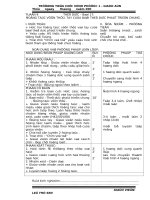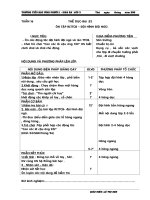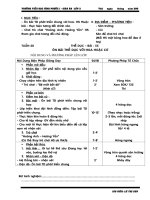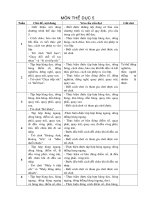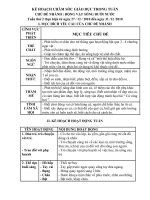Tài liệu Why Has the Cost of Fixed-Wing Aircraft Risen - A Macroscopic Examination of the Trends in U.S. Military Aircraft Costs over the Past Several Decades pptx
Bạn đang xem bản rút gọn của tài liệu. Xem và tải ngay bản đầy đủ của tài liệu tại đây (581.6 KB, 118 trang )
This document and trademark(s) contained herein are protected by law as indicated
in a notice appearing later in this work. This electronic representation of RAND
intellectual property is provided for non-commercial use only. Unauthorized
posting of RAND PDFs to a non-RAND Web site is prohibited. RAND PDFs are
protected under copyright law. Permission is required from RAND to reproduce,
or reuse in another form, any of our research documents for commercial use. For
information on reprint and linking permissions, please see RAND Permissions.
Limited Electronic Distribution Rights
Visit RAND at www.rand.org
Explore RAND National Defense Research Institute
RAND Project AIR FORCE
View document details
For More Information
This PDF document was made available
from www.rand.org as a public service of
the RAND Corporation.
6
Jump down to document
THE ARTS
CHILD POLICY
CIVIL JUSTICE
EDUCATION
ENERGY AND ENVIRONMENT
HEALTH AND HEALTH CARE
INTERNATIONAL AFFAIRS
NATIONAL SECURITY
POPULATION AND AGING
PUBLIC SAFETY
SCIENCE AND TECHNOLOGY
SUBSTANCE ABUSE
TERRORISM AND
HOMELAND SECURITY
TRANSPORTATION AND
INFRASTRUCTURE
WORKFORCE AND WORKPLACE
The RAND Corporation is a nonprofit
research organization providing
objective analysis and effective
solutions that address the challenges
facing the public and private sectors
around the world.
Purchase this document
Browse Books & Publications
Make a charitable contribution
Support RAND
NATIONAL DEFENSE RESEARCH
INSTITUTE and PROJECT AIR FORCE
This product is part of the RAND Corporation monograph series.
RAND monographs present major research findings that address the
challenges facing the public and private sectors. All RAND mono-
graphs undergo rigorous peer review to ensure high standards for
research quality and objectivity.
.BSL7"SFOBt0CBJE:PVOPTTJt,FWJO#SBODBUP
*SW#MJDLTUFJOt$MJąPSE"(SBNNJDI
Prepared for the
United States Navy and United States Air Force
Approved for public release;
distribution unlimited
NATIONAL DEFENSE RESEARCH INSTITUTE and
PROJECT AIR FORCE
8IZ)BTUIF$PTU
PG'JYFE8JOH
"JSDSBGU3JTFO
".BDSPTDPQJD&YBNJOBUJPOPGUIF
5SFOETJO64.JMJUBSZ
"JSDSBGU$PTUTPWFSUIF1BTU
4FWFSBM%FDBEFT
The RAND Corporation is a nonprofit research organization providing
objective analysis and effective solutions that address the challenges
facing the public and private sectors around the world. RAND’s
publications do not necessarily reflect the opinions of its research clients
and sponsors.
R
®
is a registered trademark.
© Copyright 2008 RAND Corporation
All rights reserved. No part of this book may be reproduced in any
form by any electronic or mechanical means (including photocopying,
recording, or information storage and retrieval) without permission in
writing from RAND.
Published 2008 by the RAND Corporation
1776 Main Street, P.O. Box 2138, Santa Monica, CA 90407-2138
1200 South Hayes Street, Arlington, VA 22202-5050
4570 Fifth Avenue, Suite 600, Pittsburgh, PA 15213-2665
RAND URL:
To order RAND documents or to obtain additional information, contact
Distribution Services: Telephone: (310) 451-7002;
Fax: (310) 451-6915; Email:
The research was conducted within the Acquisition and Technology
Policy Center of the RAND National Defense Research Institute
(NDRI) and the Resource Management Program of RAND Project
AIR FORCE (PAF). Both NDRI and PAF are federally funded research
and development centers sponsored by the Office of the Secretary
of Defense, the Joint Staff, the Unified Combatant Commands, the
Department of the Navy, the Marine Corps, the defense agencies,
and the defense Intelligence Community under contracts W74V8H-
06-C-0002 and PFA7014-06-0001.
Library of Congress Cataloging-in-Publication Data
Why has the cost of fixed-wing aircraft risen? : a macroscopic examination of the trends
in U.S. military aircraft costs over the past several decades / Mark V. Arena [et al.].
p. cm.
Includes bibliographical references.
ISBN 978-0-8330-4312-2 (pbk. : alk. paper)
1. Airplanes, Military—United States—Costs. 2. United States. Air Force—
Procurement. 3. United States. Navy—Procurement. I. Arena, Mark V.
UG1243.W54 2008
358.4'183—dc22
2008026145
iii
Preface
In recent decades, cost escalation for military fixed-wing aircraft of all
types has exceeded that of commonly used inflation indices, including
the Consumer Price Index, the Department of Defense procurement
deflator, and the Gross Domestic Product deflator.
1
A relatively fixed
investment budget (albeit one with cyclical variations) means that the
Services must somehow accommodate higher unit costs. is accom-
modation may mean buying fewer aircraft than in the past or it may
mean reprioritizing budgets between acquisition and operations and
support.
is monograph explores the causes of this unit cost escalation,
including both economy-driven factors that the Services cannot con-
trol and customer-driven factors that they can.
e research was conducted between January 2006 and Septem-
ber 2007 and was jointly sponsored by the Assessment Division, Office
of the Chief of Naval Operations (OPNAV N81) and by the Principal
Deputy, Office of the Assistant Secretary of the Air Force (Acquisi-
tion), Lt Gen Donald Hoffman, SAF/AQ, and Blaise Durante, SAF/
AQX.
e research was conducted within the Acquisition and Tech-
nology Policy Center of the RAND National Defense Research Insti-
tute (NDRI) and the Resource Management Program of RAND Proj-
ect AIR FORCE (PAF). Both NDRI and PAF are federally funded
research and development centers sponsored by the Office of the Sec-
1
is study exclusively examines manned aircraft and data. Unmanned aerial vehicles
(UAVs) are excluded from the analysis.
iv Why Has the Cost of Fixed-Wing Aircraft Risen?
retary of Defense, the Joint Staff, the Unified Combatant Commands,
the Department of the Navy, the Marine Corps, the defense agencies,
and the defense Intelligence Community.
For more information on RAND’s Acquisition and Technology
Policy Center, contact the Director, Philip Antón. He can be reached by
email at ; by phone at 310-393-0411, extension
7798; or by mail at the RAND Corporation, 1776 Main Street, Santa
Monica, California 90407-2138. More information about RAND is
available at .
Project AIR FORCE, a division of the RAND Corporation, is
the U.S. Air Force’s federally funded research and development center
for studies and analyses. PAF provides the Air Force with independent
analyses of policy alternatives affecting the development, employment,
combat readiness, and support of current and future aerospace forces.
Research is conducted in four programs: Aerospace Force Develop-
ment; Manpower, Personnel, and Training; Resource Management;
and Strategy and Doctrine. Additional information about PAF is avail-
able on our Web site: />RAND Project AIR FORCE reports that address military air-
craft cost estimating issues include the following:
In t An Overview of Acquisition Reform Cost Savings Estimates, MR-
1329-AF, Mark A. Lorell and John C. Graser use relevant litera-
ture and interviews to determine whether estimates of the efficacy
of acquisition reform measures are robust enough to be of predic-
tive value.
In t Military Airframe Acquisition Costs: e Effects of Lean Manu-
facturing, MR-1325-AF, Cynthia R. Cook and John C. Graser
examine the package of new tools and techniques known as “lean
production” to determine whether it would enable aircraft manu-
facturers to produce new weapon systems at costs below those
predicted by historical cost-estimating models.
In t Military Airframe Costs: e Effects of Advanced Materials and
Manufacturing Processes, MR-1370-AF, Obaid Younossi, Michael
Kennedy, and John C. Graser examine cost-estimating method-
ologies and focus on military airframe materials and manufactur-
Preface v
ing processes. e authors provide cost estimators with factors
useful in adjusting and creating estimates based on parametric
cost-estimating methods.
In t Military Jet Engine Acquisition: Technology Basics and Cost-
Estimating Methodology, MR-1596-AF, Obaid Younossi, Mark V.
Arena, Richard M. Moore, Mark A. Lorell, Joanna Mason, and
John C. Graser present a new methodology for estimating mili-
tary jet engine costs and discuss the technical parameters that
derive the engine development schedule, development cost, and
production costs and present a quantitative analysis of historical
data on engine development schedule and cost.
In t Test and Evaluation Trends and Costs for Aircraft and Guided
Weapons, MG-109-AF, Bernard Fox, Michael Boito, John C.
Graser, and Obaid Younossi examine the effects of changes in the
test and evaluation (T&E) process used to evaluate military air-
craft and air-launched guided weapons during their development
programs. e report also provides relationships for developing
estimates of T&E costs for future programs.
In t Software Cost Estimation and Sizing Methods, Issues and Guide-
lines, MG-269-AF, Shari Lawrence Pfleeger, Felicia Wu, and
Rosalind Lewis recommend an approach to improve the utility of
the software cost estimates by exposing uncertainty and reducing
risks associated with developing estimates.
In t Lessons Learned from the F/A-22 and F/A-18E/F Development
Programs, MG-276-AF, Obaid Younossi, David E. Stem, Mark A.
Lorell, and Frances M. Lussier evaluate historical cost, schedule,
and technical information from the development of the F/A-22
and F/A-18E/F programs to derive lessons for the Air Force and
other Services to improve the acquisition of future systems.
In t Price-Based Acquisition: Issues and Challenges for Defense Depart-
ment Procurement of Weapon Systems, MG-337-AF, Mark A. Lorell,
John C. Graser, and Cynthia R. Cook document savings and cost
avoidance on government and contractor activities resulting from
the use of price-based acquisition strategies in a manner useful
to the acquisition, planning, and cost-estimating communities,
and generate recommendations for approaches to more accurately
vi Why Has the Cost of Fixed-Wing Aircraft Risen?
assessing the potential cost savings and cost avoidance that can be
expected from the wider use of price-based acquisition.
In t Impossible Certainty: Cost Risk Analysis for Air Force Systems,
MG-415-AF, Mark V. Arena, Obaid Younossi, Lionel A. Galway,
Bernard Fox, John C. Graser, Jerry M. Sollinger, Felicia Wu, and
Carolyn Wong describe various ways to estimate cost risk and
recommend attributes of a cost-risk estimation policy for the Air
Force.
In t Systems Engineering and Program Management: Trends and
Costs for Aircraft and Guided Weapons Programs, MG-413-AF,
David E. Stem, Michael Boito, and Obaid Younossi evaluate
the historical trends and develop a cost-estimating method for
systems engineering and program management, which is one of
the most costly “below-the-line” items for military aircraft and
guided weapon systems.
In t Evolutionary Acquisition: Implementation Challenges for Defense
Space Programs, MG-431-AF, Mark A. Lorell, Julia F. Lowell, and
Obaid Younossi study how to help the Air Force acquisition com-
munity formulate policies that anticipate and respond to the pros-
pect of more widespread use of evolutionary acquisition strategies
relying on a spiral development process, as recently mandated by
the Office of the Secretary of Defense.
In t Historical Cost Growth of Completed Weapon System Programs,
TR-343-A F, Mark V. Arena, Robert S. Leonard, Sheila E. Murray,
and Obaid Younossi conduct a literature review of cost growth
studies and provide a more extensive analysis of the historical cost
growth of the completed acquisition programs.
In t Is Weapon System Cost Growth Increasing? A Quantitative Assess-
ment of Completed and Ongoing Programs, MG-588-AF, Obaid
Younossi, Mark V. Arena, Robert S. Leonard, Charles Robert
Roll, Jr., Arvind Jain, and Jerry M. Sollinger analyze completed
and ongoing weapon system programs’ development cost growth
and determine the magnitude of cost growth and show cost
growth trends for the past three decades.
vii
Contents
Preface iii
Figures
xi
Tables
xiii
Summary
xv
Acknowledgments
xix
Abbreviations
xxi
CHAPTER ONE
e Escalation of Aircraft Costs 1
CHAPTER TWO
Data and Price Trends 5
Data Sources and Normalization
5
Sources of Data and eir Content
6
Technical and Schedule Databases
7
Data Limitations
8
Adjustments and Normalization
8
Final Dataset and Systems Represented
8
Measuring Cost Escalation
9
Trends
10
Summary
15
CHAPTER THREE
Economy-Driven Factors 17
Distribution of Costs
17
Labor Rates
20
viii Why Has the Cost of Fixed-Wing Aircraft Risen?
Material and Equipment 24
Fees and Profits
27
General and Administrative Costs
27
Material Overhead
28
Fees and Profits
29
Notional Aircraft Comparisons
30
Summary
31
CHAPTER FOUR
Customer-Driven Factors 33
Quantity Effects
33
Cost Improvement
34
Procurement Rate
36
Configuration Effects
39
Basic Technical Characteristics
44
Other Elements
46
Summary
47
CHAPTER FIVE
Pairwise Comparisons 49
Economy-Driven Factors
50
Customer-Driven Factors
51
Tota l Escalation
53
CHAPTER SIX
Industry Views on Military Fixed-Wing Aircraft Cost Escalation 57
Military Fixed-Wing Aircraft Industry
57
Increased Military Utility
58
Stealth
58
Weight Reduction
59
Lean Manufacturing
61
Government Requirements
62
Berry Amendment and “Buy American” Legislation
62
OSHA and Environmental Regulations
63
Antitamper Requirements
64
International Trade in Arms Regulations
64
Summary
65
CHAPTER SEVEN
Options for the Air Force and the Navy to Reduce Fixed-Wing
Aircraft Costs
67
Make Fixed-Wing Aircraft Procurement More Stable and Predictable
68
Stabilize Project Management and Design
70
Rethink Competition Within the Industrial Base
70
Encourage International Competition and Participation
72
Improve the Process of Formulating Requirements and Capabilities
72
Focus Attention on Upgrades and Commercial Derivatives
73
Increase the Use of Evolutionary Acquisition Principles
74
Lessons Learned from the F-22A and F/A-18E/F Development
Programs
75
Summary
76
CHAPTER EIGHT
Conclusion 79
APPENDIX
A. Aircraft Included in the Analysis 83
B. Survey of Industry
89
Bibliography
91
Contents ix
xi
Figures
S.1. Contributors to Price Escalation from the F-15A (1975)
to the F-22A (2005)
xvii
1.1. Cyclical Defense Procurement Outlays, Between Fiscal
Years 1960 and 2008
2
1.2. Annual Quantity of Aircraft Procured, 1974 to 2005
3
2.1. Average Unit Procurement Costs for Fighter Aircraft, by
Fiscal Year, 1974 to 2005
13
2.2. Average Unit Procurement Costs for Electronic Aircraft,
by Fiscal Year, 1974 to 2005
14
3.1. Labor, Equipment, and Material Percentages of Weapon
System Cost, 1969 to 2003
19
3.2. Average Annual Growth for Aerospace Labor Costs,
1989 to 2005
20
3.3. Annual Direct and Burdened Labor Costs from a Select
Set of Aircraft Programs, Fiscal Years 1969 to 2003
22
3.4. Percentage of Labor Hours by Subcomponent, 1969
to 2003
23
3.5. Aerospace Labor Productivity, 1987 to 2003
24
3.6. Material and Equipment Price Escalation, 1986 to 2004
26
3.7. G&A Percentage of Total Cost, by Fiscal Year, 1969 to
2003
28
3.8. Material Overhead Percentage, by Fiscal Year, 1969 to
2003
29
3.9. Operating Margin for Aircraft Sector, by Year, 1975 to
2005
30
6.1. Trend in Composite Material Use in Aircraft, 1967 to
2000
60
xiii
Tables
2.1. Average Annual Cost Escalation for Aircraft and Inflation
Indices, 1974 to 2005
11
2.2. Average Annual Escalation Rate for Unit Procurement and
Flyaway Costs for Various Navy Aircraft, 1974 to 2000
13
3.1. Average Distribution of Labor, Equipment, and Material
Costs for a Select Group of Fixed-Wing Aircraft, 1969 to
2003
18
3.2. Direct and Indirect Annual Escalation Rates for Labor
Subcomponents, 1969 to 2003
22
3.3. Material and Equipment Escalation Rates, 1986 to 2004
27
3.4. Contributions of the Economic Factors to Cost Escalation
for a Notional Example
31
4.1. Cost Improvement Slopes, by Minimum Number of
Annual Buys
35
4.2. Cost Improvement and Production Rate Slopes, by
Minimum Number of Annual Buys
37
4.3. Cost Improvement and Production Rate Slopes with a
Minimum of Five Annual Buys
38
4.4. Aircraft Models’ Long-Term Production Profiles and
Dates of Configuration Change
40
4.5. Results of Regression Incorporating Configuration
Change Effects
42
4.6. Results of Regressions on Technical Characteristics
45
4.7. Results of Regressions on Airframe Materials Complexity
46
5.1. Percentage Contributions to Annual Cost Escalation, by
Economy-Driven Factors
50
xiv Why Has the Cost of Fixed-Wing Aircraft Risen?
5.2. Percentage Contributions to Annual Cost Escalation,
by Customer-Driven Factors
52
5.3. Percentage Contributions to Annual Escalation Rate
54
A.1. Aircraft Systems and Types Used in the Analyses
84
xv
Summary
As with many other military weapon systems, military aircraft have
experienced long-term, unit cost increases that are greater than the rate
of inflation.
1
ese increases, largely driven by the desire for greater
capabilities, appear likely to persist and could have dire implications
for aircraft inventories, particularly given relatively fixed defense
investment budgets. Commenting on the continually increasing costs
for aircraft, one industry executive (Augustine, 1986, p. 143) famously
wrote,
In the year 2054, the entire defense budget will purchase just one
aircraft. e aircraft will have to be shared by the Air Force and
Navy 3½ days per week except for leap year, when it will be made
available to the Marines for the extra day.
Given increasing costs for military aircraft, relatively fixed bud-
gets to procure them, and resulting decreased procurement rates, the
Air Force and the Navy asked RAND to examine the causes of military
aircraft cost escalation. From available data, we calculated cost esca-
lation rates as well as their “economy-driven” and “customer-driven”
causes.
For every type of aircraft we examined—patrol, cargo, trainer,
bomber, attack, fighter, and electronic warfare—annual unit cost esca-
1
roughout this document, we use the terms price and cost interchangeably. Formally, in
most cases we are referring not to cost but to what cost estimators term as price, that is, the
actual dollars required to buy the system (including all fees and profits). By cost increase (or
cost escalation), we mean the differences in actual prices paid for aircraft over time and not
the difference between the estimated and actual values.
xvi Why Has the Cost of Fixed-Wing Aircraft Risen?
lation rates in the past quarter century have exceeded common infla-
tion indices, such as the Consumer Price Index, the Department of
Defense procurement deflator, and the Gross Domestic Product defla-
tor. is trend is true whether cost escalation is measured using either
procurement or flyaway cost. Patterns of cost escalation differed by
aircraft—some showed cost improvement over time, while others
steadily increased—but, again, all exceeded that for other inflation
measures.
We considered two groups of contributors to cost escalation:
economy-driven variables, which include costs for labor, equipment,
and material, and customer-driven variables, which include costs for
providing performance characteristics that the Services want in their
aircraft.
We found that the rates ($/hr) of aircraft manufacturing labor,
in both direct and fully burdened wages, have increased much faster
than other measures of inflation. Nevertheless, increased productivity
has meant that overall, labor costs have grown only slightly faster than
inflation. Furthermore, the proportion of labor cost in the overall cost
of aircraft has been steadily decreasing (from a prime contractor per-
spective) as more manufacturing is outsourced. With two exceptions
(specialty metals and avionics systems, such as navigation equipment),
materials and equipment used in aircraft manufacturing have increased
in cost at roughly the same rate as other measures of inflation. Alto-
gether, we find that labor, material, equipment, and manufacturer fees
and profits have helped increase the cost of aircraft about 3.5 percent
annually—which is less than the rate of increase for some inflation
indices during the same time.
e government can affect the cost of military aircraft in several
ways, particularly through the quantity it demands and the characteris-
tics it specifies. Although we did not find a consistent cost improvement
effect stemming from purchases over time in aircraft procurement, we
did find a procurement rate effect by which higher production rates
helped reduce unit prices. One reason for this may be the economic
leverage from larger purchases that allows manufacturers to invest in
efficiency improvements. Other possible reasons are the spreading of
fixed overhead costs over more units—thus reducing average unit price.
Another explanation could be more efficient use of labor and tooling
when production rates are higher.
When considering comparison pairs of aircraft, we found that
complexity of the aircraft (performance characteristics and airframe
material) contributed to aircraft cost escalation, often at rates far exceed-
ing those of inflation. Figure S.1 shows the contributions of the vari-
ous factors to cost escalation when comparing an F-15A (1975) to an
F-22A (2005). e chart shows that roughly a third of the overall cost
escalation is due to economy-driven factors. e remainder is due to
customer-driven ones—mainly system complexity.
Interviews that we conducted with representatives of aircraft man-
ufacturers confirmed many of these findings. In particular, these repre-
sentatives noted that the increased demand for greater aircraft stealth
and reduced aircraft weight contributed to cost escalation. ey also
cited government regulations, such as those designed to protect Ameri-
can industry and technology and those for environmental protection
and occupational health as sources of aircraft cost escalation.
Figure S.1
Contributors to Price Escalation from the F-15A (1975) to the F-22A (2005)
Customer-driven
factors
Economy-driven
factors
RAND MG696-S.1
10
8
6
4
2
12
0
Annual escalation rate, %
Production rate and
learning
Complexity
General and
administrative
Labor
Equipment
Regulatory
Material
Summary xvii
xviii Why Has the Cost of Fixed-Wing Aircraft Risen?
e Services could choose to address cost escalation in several
ways, some more feasible than others. Improved procurement stabil-
ity and longer-term contracts could encourage manufacturers to make
investments to increase efficiency and cut costs. Fewer change orders
to aircraft may help reduce costs as well. International competition
and participation in the construction of military aircraft could also
reduce costs, although this would likely be opposed by Congress and
might be feasible only for noncombat aircraft. Focusing on aircraft
upgrades in successive model improvements rather than on acquisition
of new aircraft types, as has been done for several aircraft (e.g., the F/A-
18E/F), could help contain procurement cost escalation, although the
age of some existing aircraft may limit the application of this practice.
At present, the Air Force and the Navy appear to be opting for
fewer aircraft but with the highest technological capabilities. Such a
strategy helps ensure that U.S. aircraft remain far superior to those of
any other military in the world. Maintaining such capabilities, however,
does have a cost. We do not evaluate whether this particular tradeoff
is good or bad. We note only that it exists and point out related issues
that the Services will have to address in deciding how to allocate future
appropriations for aircraft procurement.
xix
Acknowledgments
Many individuals contributed to this study and we would like to thank
them. First, we thank Trip Barber of OPNAV N81 for both cosponsor-
ing this study and providing very useful input and guidance along the
way. We would also like to thank Blaise Durante (SAF/AQX) for also
cosponsoring this project and for his long-term support of Project AIR
FORCE’s cost research.
We are grateful to the U.S. manufacturers and their parent
organizations—Boeing, Lockheed Martin Corporation, and Northrop
Grumman Corporation—for their time and insight. Particularly, we
thank Laura Russell and Ken Goeddel (Boeing); Richard Janda, Larry
McQuien, and Doug Steen (Lockheed Martin); and Chris Bowie
(Northrop Grumman) for coordinating our interactions with industry
and providing helpful data for the study. We are also grateful to David
Burgess, Donald Allen, and Soroja Raman of NAVAIR for helpful
technical discussions and data on Navy fixed-wing programs. Richard
Hartley (SAF/FMC) and Jay Jordan from the Air Force Cost Analysis
Agency provided similar help and guidance for Air Force systems.
Finally, we acknowledge both reviewers of this document: John
Graser (RAND) and Bill Stranges (former NCAD and NAVAIR offi-
cial). eir comments and suggestions greatly improved this work.
xxi
Abbreviations
ACEA Arms Control Export Act
APN Aircraft Procurement Navy
B&P bid and proposal
BLS Bureau of Labor Statistics
CAD computer-aided design
CAIV Cost as an Independent Variable
CAM computer-aided manufacturing
CBO Congressional Budget Office
CC configuration change
CCDR Contractor Cost Data Report
CDRL Contract Data Requirements List
CFE contractor-furnished equipment
CI cost improvement
CIC cost improvement curve
CPI Consumer Price Index
CTOL conventional take off and landing
CV carrier version
DCARC Defense Cost and Resource Center
DoD Department of Defense
ECI Employment Cost Index
EVM earned value management
EW empty weight
xxii Why Has the Cost of Fixed-Wing Aircraft Risen?
FY fiscal year
G&A general and administrative
GDP Gross Domestic Product
GFE government-furnished equipment
HAPCA Historical Aircraft Procurement Cost Archive
IPT integrated product team
IR&D internal research and development
ITAR International Trade in Arms Regulations
JSF Joint Strike Fighter
LM Lockheed Martin
MMA multi-mission maritime aircraft
NASA National Aeronautics and Space Administration
NATO North Atlantic Treaty Organization
NAVAIR Naval Air Systems Command
NGC Northrop Grumman Corporation
OPNAV Office of the Chief of Naval Operations
OSD Office of the Secretary of Defense
OSHA Occupational Safety and Health Administration
PA&E Program Analysis and Evaluation (OSD)
PPI Producer Price Index
PR procurement rate
QC quality control
R&D research and development
RAM radar absorbing materials
SAR Selected Acquisition Report
SEC Securities and Exchange Commission
STOVL short take off and vertical landing
UAV unmanned aerial vehicle
USAF U.S. Air Force
USN U.S. Navy
1
CHAPTER ONE
The Escalation of Aircraft Costs
Commenting on the continually increasing costs of military aircraft,
Norman Augustine (1986, p. 143) famously observed,
In the year 2054, the entire defense budget will purchase just one
aircraft. is aircraft will have to be shared by the Air Force and
Navy 3½ days per week except for leap year, when it will be made
available to the Marines for the extra day.
Augustine based this prediction on costs for individual aircraft that
had grown by a factor of four every decade, with increases more closely
related to the passage of time than to modifications in speed, weight,
or technical specifications.
e trends that Augustine observed have persisted across time and
weapon systems. Unit costs for weapons have typically grown at least
5 percent annually, with those for advanced weapon systems such as
tactical aircraft growing 10 percent annually (Hellerman, 2003; Kirk-
patrick, 2004). Among recent aircraft series, for example, the unit costs
for the F-15 increased from $11.9 million in 1974 (as measured in then-
year dollars) to $54.0 million in 2000.
1
Eskew (2000) observed that
the real cost escalation (beyond inflation and performance growth) for
military aircraft is about 3 percent per year.
Although design improvements may explain some increases, it is
remarkable that other advances have not helped minimize them. As
1
Expressing this difference in constant 2006 dollars, the trend is $44.0 million in 1974
versus $58.6 million in 2000.
